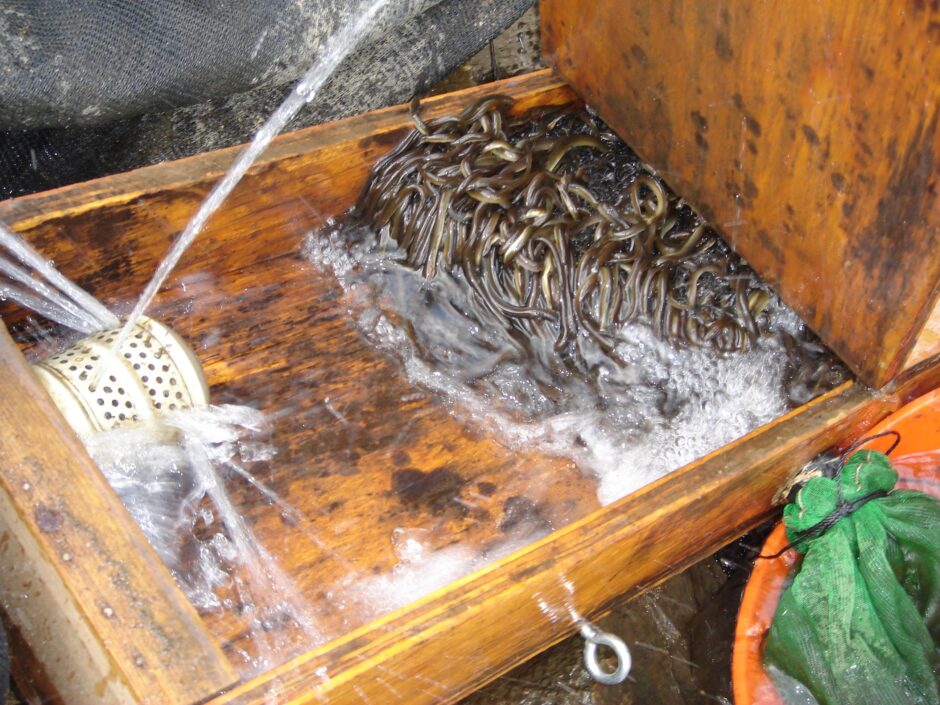Eel Conservation in the United States and Europe
 Juvenile eels, or elvers, in a ramp for passage study at Conowingo Dam. (Credit: Maryland Fishery Resources Office, USFWS via Flickr Public Domain)
Juvenile eels, or elvers, in a ramp for passage study at Conowingo Dam. (Credit: Maryland Fishery Resources Office, USFWS via Flickr Public Domain)Unpopular with anglers and not known for being particularly charismatic with locals, eel conservation is often pushed to the back burner. A matter particularly concerning as the species is still fished commercially, and the species like the European eel have been listed as critically endangered. Across the pond, the American eel is considered endangered but less threatened by extinction than its European counterpart.
Recent reports found that 90 percent fewer European juvenile eels, or elvers, are returning to rivers after spawning. Similar to other migratory aquatic species, overfishing, pollution and climate change have been cited as explanations for the species’ decline. However, research focusing on dams and other hydropower infrastructure proves that the barriers are a significant obstacle to the migrating fish as they head out to spawn at sea.
How Dams Impact Migratory Fish
While some dams have designed and integrated a few strategies to mitigate migratory disturbances, many methods are unsuccessful and still inhibit fish passage. For many fish, the dams are more than simply a physical barrier—they also present water quality issues and potential hazards for fish.
A 2015 study from the University of Southampton suggests that increasing flow velocity near hydropower turbine intakes makes eels more wary of the spinning blades and causes them to seek safer routes.
University researchers tracked the movements of 40 tagged adult eels near a manipulated hydropower intake and found that the fish exhibited “search” behavior when flow velocity was low. The search behavior inadvertently placed the eels at a greater risk of being caught by hydroelectric turbines as they dive deeper to explore underwater structures. However, when the flow was manipulated to higher velocities, the fish seemed to avoid the turbines more often, escaping upstream to seek another passage.
Conclusion
The results of the study reveal how dams present more than a physical barrier to aquatic species. It also calls into question the effectiveness of structures like fish passages. If these passages are failing fish, then flow behavior from the dam could spell trouble for migrating eels. Instead, dam outputs and flow dynamics below the structure are controllable variables that might mitigate impediments to migration.
“This interdisciplinary research provides hope that behavioral deterrents may be developed to divert eels away from hazardous routes during their downstream migration,” said lead author Paul Kemp in a university press release.
Due to the more threatened status and greater interest in European eels, the species has received more dedicated research and conservation efforts. American eels are less popular and, as such, have received less focus from the scientific community and aren’t a high priority for conservation.
Still, eels are important members of the ecosystems they inhabit and for communities interested in the fish recreationally and commercially. In 2012, a pound of glass eels was valued at $2,600 a pound, according to Scientific American. The boom in popularity in the early 2010s was initially responded to with moves to place restrictions on eel fisheries, but anglers called for a better way, pointing out the damage done by dams.
One way or another, American eel populations are still unstable and will require the attention of resource managers and scientists to protect the species from slipping closer to extinction. These changes may come in the form of regulations or dam removal, though the changes can’t come soon enough.


0 comments